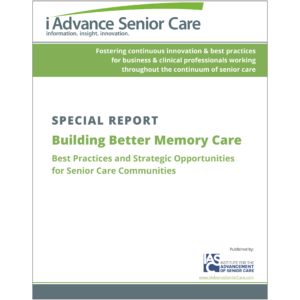Confronting the risk of elopement
You’ve received a call from the local hospital that one of your residents, after being found on the street by the police, has been brought to the emergency room for treatment of dehydration and a laceration to the forehead. At the time of the elopement, the nursing assistant assigned to the resident had gone home early, leaving the unit staffed by only one other employee. When you phone the unit to confer with the charge nurse, she has no information about a missing resident.
Similar incidents of elopement occur in nursing homes more frequently than we wish to imagine. Ten percent of all lawsuits involving nursing homes deal with elopement. Seventy percent of these lawsuits involve the death of a resident, and in 80% of cases the resident experienced prior incidences of elopement or attempted elopements.
Not only can the elopement of a resident with known risks result in significant deficiencies, often including stiff financial penalties if the facility is found at fault, but more importantly, the consequences to the resident can be life-threatening. Primary causes of elopement-related deaths include being struck by a vehicle, exposure to heat or cold, and drowning. Moreover, the public’s trust in the facility can be jeopardized.
Elopement is widely defined as a dependent resident leaving a facility without observation or knowledge of departure and under circumstances that place the resident’s health, safety, or welfare at risk. The definition of “at risk” varies greatly, and frequently depends on facility location. For example, in an urban area, at risk may simply mean walking out the front door onto a busy intersection, whereas in a rural area, the facility may be surrounded by grounds that might provide some safety to a resident outside the building. Most states have their own statutes that govern elopement and include criteria such as the length of departure (once the resident leaves the grounds or once the resident has been declared missing for a designated period of time if no injury has occurred) and whether “elopement” actually occurs once the resident leaves the facility, the facility grounds, or the surrounding area.
According to the recently revised federal regulation 42 CFR 483.25(h)(1) and (2), F323 Accidents and Supervision, elopement occurs when a resident leaves the premises or a safe area without authorization and/or the necessary supervision to do so.
Facility policies and practices that clearly define procedures for monitoring, managing, and supervising residents at risk for elopement provide the best means for minimizing the chances of elopement and life-threatening results. Establishing a systematic, well-practiced approach to identifying and managing elopement risk is the best way to minimize litigation and safeguard your residents. Consider these strategies for your written elopement plan and program:
Identify an ongoing method (risk assessment) to determine residents who may be at risk for elopement. The assessment should include an evaluation of physical, emotional, and psychological factors that can help to determine whether a resident can be properly and safely cared for by the facility. Assessments should be completed on the day of admission, quarterly, and when changes in behavior or cognition occur.
Implement interventions to reduce the risk of elopement that are consistent with the resident’s needs, goals, and plan of care. Monitor the effectiveness of these interventions and modify them as needed to minimize the likelihood of elopement.
Evaluate the environment. Approximately 50% of elopements occur within the first days of admission; therefore it is important to place new residents in rooms away from exits, limit the level of sensory stimulus, provide adequate oversight, educate family and staff about the resident’s risks, and monitor, document, and redirect unusual behavior or wandering patterns. Security monitors and activation alarms should be used consistently and properly. Staff members who turn off alarms or security monitors even for short periods of time place the facility at much greater risk for resident elopement.
Consider events that require resident redirection from an exit as “near misses” related to elopement just as you would consider a stumble in which the staff intervened to prevent a fall a “near miss” fall. Attempt to determine the root cause of an attempted elopement, evaluating unmet needs or other factors triggering the behavior. Based on the root causes and behavior patterns, update the plan of care to reflect the resident’s safety interventions.
Consistently communicate to all who need to know about your elopement-risk residents and their individualized care planned interventions. Remember that staff members from housekeeping, activities, dietary, and therapies can also participate in observing and redirecting wandering or eloping residents.
Educate nursing staff about documentation and reporting guidelines and procedures for responding to an elopement. Remind staff members that many elopements occur in the late afternoon and evening hours when residents become more confused and when fewer staff members may be available to supervise, or because alarms are turned off or not promptly responded to. Mealtimes are also high-risk times for elopement.
Finally, the facility emergency preparedness plan should include well-defined and immediate steps to locate residents once they are determined to be missing, including:
Photographic identification of residents
Steps to complete a thorough facility and grounds search
Notification and reporting guidelines to families, the physician, the director of nursing, the administrator, and local law enforcement
Detailed documentation of elopement circumstances, if known, search and recovery efforts, resident status, treatment, and immediate steps taken to safeguard the resident and others from further elopement
Periodic elopement drills to assess the effectiveness of missing resident protocols and practices
Elopement can bring life-threatening risks to residents and serious citations and litigation exposure to facilities. Facilities can face civil or criminal charges for not ensuring adequate monitoring for residents at risk for elopement. Implementing effective and individualized interventions to minimize the risk of elopement and educating staff to effectively manage the facility’s elopement program and emergency preparedness plan are the best means to safeguarding the facility and its residents.
Jan Bennet RN, NHA, is the Executive Vice-President of the American Association of Nurse Executives (AANEX). For more information, phone (877) 457-7208 or visit
To send your comments to the author and editors, please e-mail bennet0108@nursinghomesmagazine.com
Suggested Reading
- Resident Elopement: Facts, Prevention, Responding Tools & References, Health Care Solutions for a Changing World, Briggs.Information retrieved from https://www.guideone.com/SafetyResources/SLC/Docs/elopementbrochure.pdf.
- Resident Elopement: Managing the Liability Risks of Wandering, Kelly J. Taylor, RN, JD, CNA, 2002, Volume 7, Issue 1.
- State Operations Manual, Appendix PP – Guidance to Surveyors for Long Term Care Facilities, 42 CFR 483.25(h)(1) and (2), F323 Accidents and Supervision.
I Advance Senior Care is the industry-leading source for practical, in-depth, business-building, and resident care information for owners, executives, administrators, and directors of nursing at assisted living communities, skilled nursing facilities, post-acute facilities, and continuing care retirement communities. The I Advance Senior Care editorial team and industry experts provide market analysis, strategic direction, policy commentary, clinical best-practices, business management, and technology breakthroughs.
I Advance Senior Care is part of the Institute for the Advancement of Senior Care and published by Plain-English Health Care.
Related Articles
Topics: Articles , Clinical , Facility management











